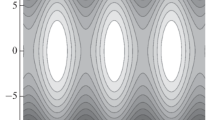Abstract
Asymptotic forms are obtained and solved for the equations of motion of aerosol particles in various flow fields. The flows chosen to be treated include regions of strong curvature of the fluid streamlines, and regions where the initial motion of the particles differ from that of the undisturbed flow. It is shown that regular perturbations cannot yield the correct details of the trajectories of the particles in such regions, and that singular perturbations must be applied. The parameters whose magnitude control the phenomena come out to be the Stokes numbers, the curvature of the fluid streamlines, and the stopping distance of the aerosol articles. In principle this analysis is analogous to the derivation of the classical boundary layer equations. However, the classical boundary layer equations are field equations, which describe the flow in an Eulerian fashion, and therefore apply to a certain domain, geographically fixed in the field. The aerosol equations of motion considered here are Lagrangian, and as the particles move they carry with them the equations whose perturbed form must thus be modified by the fluid flow encountered along the trajectories traced by the particles. The forms assumed by the perturbed equations of motion are, therefore, different in the various cases treated. Analytical solutions are obtained for two cases which until now were handled only numerically, i.e., particle motion in viscous stagnation flow, and injection of particles into a laminar boundary layer on a flat plate. The comparison with numerical solutions shows that this new method gives rather good approximations.
Similar content being viewed by others
References
C. Gutfinger, and G. Tardos, Theoretical and experimental studies on granular bed filtration. Atmos. Environ. 13 (1979) 853–867.
D.H. Michael and P.W. Norey, Particle collision efficiencies for a sphere. J. Fluid Mech. 3 (1969) 565–575.
I. Langmuir and K. Blodgett, U.S. Army Air Force Technical Report no. 5418 (1946).
I.B. Stechkina, A.A. Kirsh and N.A. Fuchs, Studies on fibrous aerosol filters, IV. Calculation of aerosol deposition in model filters in the range of maximum penetration. Ann. Occup. Hyg. 12(i) (1969) 1–8.
D.O. Banks and G.J. Kurowski, A perturbation model for the computation of collector efficiency for axially symmetric collectors. Aerosol Sci. Technol. 3X (1984) 327–334.
M. Fichman, D. Pnueli and C. Gutfinger, Aerosol deposition in the vicinity of a stagnation point. Aerosol Sci. Technol. 13 (1990) 281–296.
S.K. Friedlander and H.T. Johnstone, Deposition of suspended particles from turbulent gas streams. Ind. Engng. Chem. 49 (1957) 1151–1156.
J. Kevorkian and J.D. Cole, Perturbation Methods in Applied Mathematics. Springer-Verlag, New York Heidelberg Berlin (1981).
H. Schlichting, Boundary Layer Theory. 7th Ed., McGraw Hill Co., New York, (1979).
Author information
Authors and Affiliations
Rights and permissions
About this article
Cite this article
Fichman, M., Pnueli, D. & Gutfinger, C. On the perturbed equations of motion of aerosol particles in regions of strong curvature of the fluid streamlines. J Eng Math 29, 141–160 (1995). https://doi.org/10.1007/BF00051740
Received:
Accepted:
Issue Date:
DOI: https://doi.org/10.1007/BF00051740



